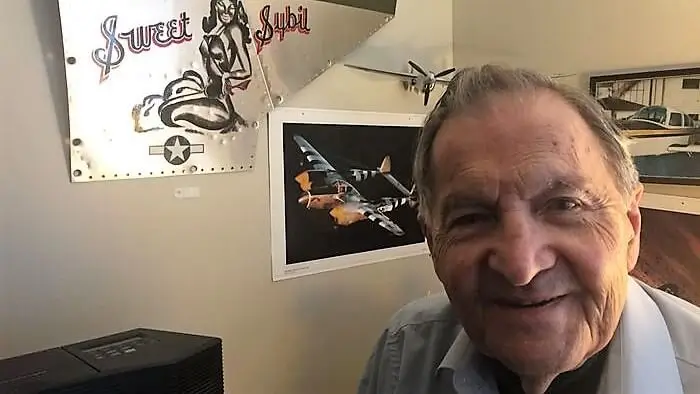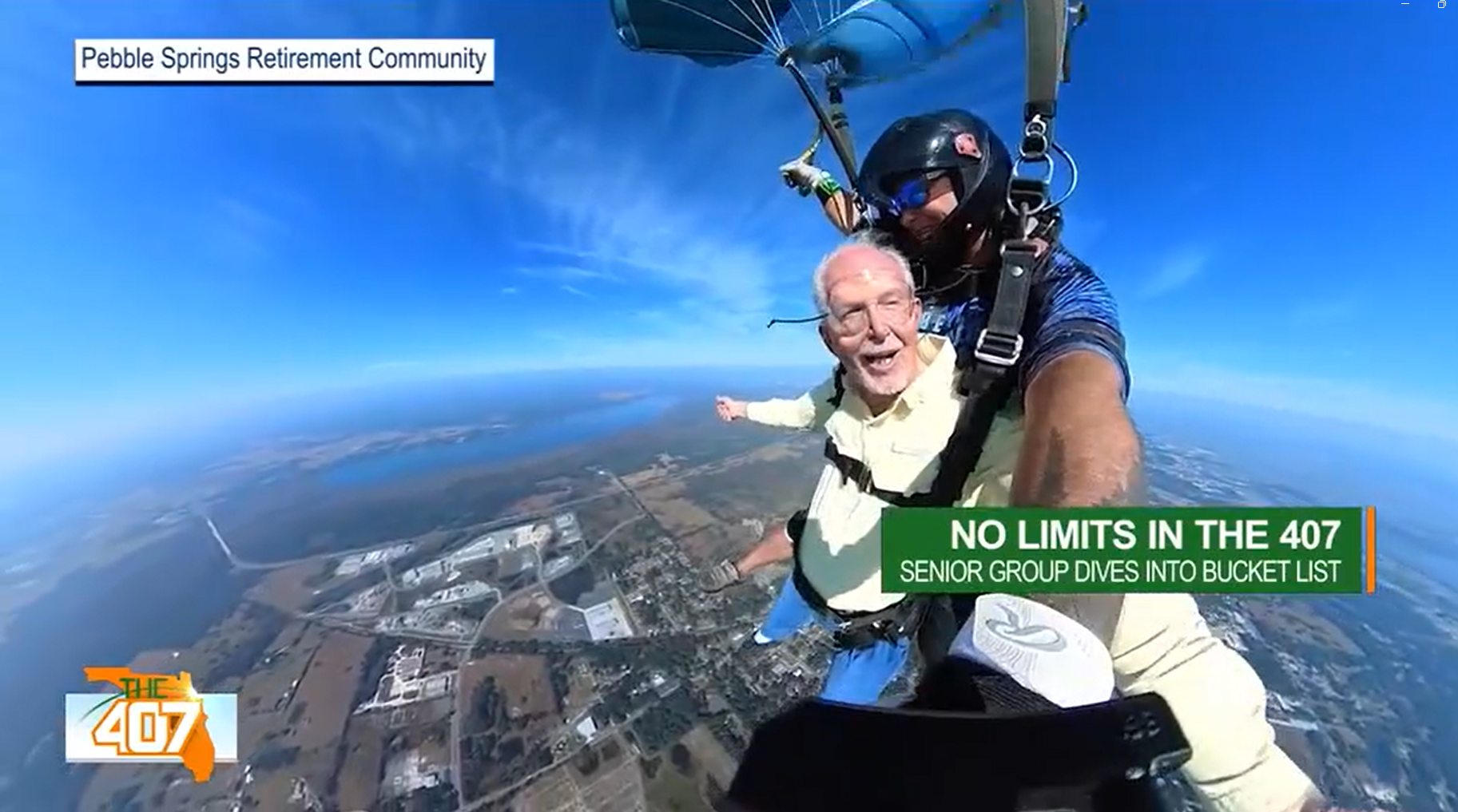By Don Cazentre | dcazentre@nyup.com
From the first time he saw an airplane as a boy in rural Oswego County, Paul Stobnicke knew he wanted to fly. After World War II broke out, he joined the U.S. Army Air Corps and became a fighter pilot.
"So I got to fly -- and it was just as exciting as I thought," Stobnicke said. "But it was war. I lost a lot of friends, saw a lot of destruction.
"I hope that no one ever has to go through that again."
It was 75 years ago this summer that Stobnicke and his comrades battled through the last stages of World War II, following the defeat of Nazi Germany in May 1945 with the victory in the Pacific by August.
He sometimes has trouble remembering the names of every Pacific island he stopped on: New Guinea, Celebes, Mindanao, Zamboanga, Luzon … . After all, he is 96, it was a long time ago and, he says, "there were so many islands."
But his memory of those times is still quite sharp. He's sure he was in the Phillippines when the first atomic bomb was dropped on Hiroshima on Aug. 6,1945.
Not long afterward, a superior officer came to the base where Stobnicke and his fellow pilots were preparing for the dangerous task of flying over and attacking the Japanese mainland.
"Fellas," the officer said. "Your war is over."
Those war experiences shaped the man Stobnicke became. It was then he met his wife, Sybil — whose nickname (Sweet Sybil) he had painted on the nose of his fighter plane. It was during the war that he first practiced his life-long passion of flying.
It was the war that helped inspire and prepare him for his eventual career: He became a long-time doctor in private practice in Syracuse and later medical director for the Syracuse City School District.
Today, Stobnicke, known to everyone as "Dr. Paul," is a resident of Towne Center Retirement Community in Fayetteville, where he still occasionally offers medical advice and care to his fellow residents.
Before the coronavirus, he gave frequent talks and lectures there on both medicine and the war. He's also entertained groups with his fine singing voice.
"He is a celebrity among the residents and staff," said Tom Snyder, a fellow retired doctor living at Towne Center. "He fills the auditorium with his lectures."
Like many in his generation, Stobnicke doesn't boast about his war experience. But he'll talk about it candidly and openly.
"I guess you'd have to say it made me who I am in a way," he said. "It's not something you can erase from your experience."
Flying toward the war
When Paul Stobnicke is asked to talk about his experiences in World War II, he usually starts a decade earlier with the day he saw his first airplane. He was about 8 or 9, in a field near his home on a farm in a rural part of the town of Oswego.
"I heard the plane flying just above the trees," he said. "It was a beautiful gold and blue Army Air Force bi-wing plane with an open cockpit. And the pilot was so close that I could see his face smiling and he certainly seemed to be happy flying about 25 feet over the trees.
"And he waved at me and I waved at him and I knew from that moment on that flying was going to be part of my life."
Stobnicke was born on June 12, 1924. He notes with some pride that it's also the birth date of President George H.W. Bush, who also went on to become a World War II pilot.
Stobnicke got his chance to fly after the bombing of Pearl Harbor in December 1941. He was just 17, and he had to get his widowed mother's permission to enlist. When he did, he got his wish and went to flight school.
He took to it right away.
"It was just something I felt I was born to do," he said. "I've never had a fear of flying in any situation."
Flight school near Ontario, Calif. also brought him into contact with a local girl, Sybil Barnes, who he met in a drugstore near the base.
"That's another reason why I feel aviation has had such a big part of my life," he said. He and Sybil married after the war.
Paul Stobnicke flew a variety of planes in training and in his initial war-time duties. But the aircraft that came to define his time in the Army Air Corps was the P-38 Lightning.
It had a distinctive look, with twin engines on booms along either side of the fuselage and a connecting piece in the rear -- the P-38 looked like a flying rectangle with wings.
At first, Stobnicke and other pilots disliked its lack of maneuverability but grew to appreciate it better when a system called "power-assist" for the ailerons was added. "(That was) a sort of power-steering for airplanes," Stobnicke said.
Stobnicke had served stateside from the end of his training until the middle of 1944. That's when he shipped out to the South Pacific and his first overseas base at Sansapor, New Guinea.
He was then a lieutenant in the U.S. Army Air Corps (the predecessor to the U.S. Air Force). He was assigned as a pilot in the air corps' 13th Air Force, 70th Fighter Squadron. That last unit was nicknamed the Jungle Squadron or the White Knights.
This was during a time when American forces, led by Gen. Douglas MacArthur, were island-hopping and inching ever closer to the far-off Japanese mainland.
As a newcomer to the war zone, Stobnicke initially got less-than-glamorous tasks to perform. That's the set-up to one of his favorite stories.
He and some fellow pilots had been assigned to "ferry" P-38s from one base to another, a job they found "a little boring." They were itching for combat duty.
One one occasion, Stobnicke led a squad of pilots bringing four P-38s to their base.
"On the way back, I said, 'Hey guys, let's put on an airshow!' " Stobnicke recalls. He urged his comrades to join him in some showy maneuvers.
"So I came screaming down across our base at 450 mph and then I did an Immelmann roll (an acrobatic maneuver)" he said. "The other guys did similar things and we went on like that for about a half-hour before we landed."
When they got out of their planes, they heard a loudspeaker command ordering them to report to the base tower.
"I looked at the others and said, 'Hey guys we may end up as privates," he said.
"So we get to the commander and he looks at me and says, 'I understand you were responsible for this,' " Stobnicke recalled. "So then he started in and berated us for what seemed like a really long time. It just continued and we just had to stand there."
"And then I'm looking at him, and he has wings (on his uniform) like we do and suddenly he smiles. And then he says, 'Paul, that was the best ---damned air show I've seen!'
"And then he looks at me and says, 'What were you thinking when you did that?' And I said we were getting tired of just ferrying airplanes. That's not what we're here for.
"He said, 'I can fix that.' Two weeks later we were moved into full-blown combat."

Dr. Paul Stobnicke, 96, traces the path of American forces in the South Pacific in a book about World War II. He was a fighter pilot in th U.S. Army Air Corps and now lives at Towne Center Retirement Community in Fayetteville.
'You have a mission to do'
Among Stobnicke's early combat experiences was providing air cover for the Battle of Leyte Gulf, the largest naval battle of the entire war.
"We were there to support the Navy pilots, and that's when I came to appreciate them because they had to land on those tiny little (aircraft) carrier decks," he said. "I did a lot of things in the war but I never had to land on a carrier."
At some point, Stobnicke took his P-38 into a steep dive during a mission, and it ended up damaged. So he got a newer, better model.
That's the P-38 a gunnery sergeant in the unit painted with the image of a buxom female figure and the words "Sweet Sybil" on the nose, for Stobnicke's girlfriend back home. It would remain his plane through the rest of his combat experience.
Although Stobnicke was classified as a fighter pilot, he more often ended up on bombing missions, along with escorts and reconnaissance. "I think overall, the P-38 had more bombing missions than anything else," he said.
But those bombing runs were not the kind where the plane flies high above the target and drops its payload through a hatch. Many were what Stobnicke calls "skip bombing," where the plane flies relatively low and fast and then releases the bomb, which is thrust forward toward the target.
Many of those targets were ships, oil fields, or the mouths of island caves where Japanese soldiers were taking cover.
During one attack, on a Japanese cruiser, Stobnicke had one of the closest calls of his combat experience. He was trying to come out of a deep dive when his right engine quit.
"That's when I really appreciated the P-38′s twin engines," he said. "The rest of the squadron was well ahead of me. I could not have made it back to base on one engine, and would have had to bail out into the ocean, hoping for the Navy to pick me up."
So with his left engine keeping him airborne, he performed a maneuver on the other called "feathering the prop." It worked, the engine caught and he made it back to base.
And only once did Stobnicke come close to what might be called a "dogfight," the kind of one-on-one action between two pilots that books and movies sometimes portray as glamorous.
But that's not how it felt to Stobnicke.
"First, we never did try to dogfight Zeros (the top Japanese fighter planes), because they could out turn you -- they didn't have the weight we did," he said.
There was one time when Stobnicke and his P-38 encountered a different kind of Japanese fighter known as a Hamp. Stobnicke flew high and got behind the Hamp, and dove to attack, firing down on the Japanese plane.
"Remember, I had a cannon and four machine guns in my nose," he said. The Hamp "took a couple of bursts and I could see bullets hitting his plane. Then he immediately parachuted out."
"So it wasn't much of a dogfight," Stobnicke said. He let the pilot go, "because I wasn't about to shoot a pilot in the air trying to getaway. It was an unwritten rule. I don't know anyone in the air force who would have shot a parachuting pilot."
Although dogfights may have been romanticized over the years in books, movies, and TV shows, Stobnicke sees it differently.
"There's nothing romantic about it," he said. "Some of those conversations you hear in the movies -- that's not the conversation you hear at all."
"You have a mission to do and you know it might be your last," he said. "You just did the best you could."

A story and photo from the Oswego Palladium-Times in 1945 chronicles Paul Stobnicke's exploits in World War II. Stobnicke was from Oswego and now lives in Fayetteville.
The Atom Bomb and the end of the war
The end of the war was coming, but pilots, sailors, and soldiers on the front lines like Paul Stobnicke didn't always know what was happening.
"People back home could read headlines," he said. "I think we found out about (the victory in Europe in May 1945) when a pilot was transferred in and told us."
His own exploits were sometimes reported to the people back home: On June 5, 1945, the Oswego Palladium-Times had a story with the headline: "Lt. Stobnicke in Jungle Air Force: Recently aided in destroying 11,000 tons of Jap shipping."
The relentless move north toward Japan continued. Atomic bombs were being delivered to a base on Tinian Island, but Stobnicke and his comrades at their base in the Philippines had no way of knowing that.
"We were preparing to go to Okinawa (a big island near Japan) so we could start the invasion and attack the Japanese mainland,' he said. "I think most of us realized we probably would not have returned from that."
Then came Aug. 6, 1945. The first atomic bomb destroyed Hiroshima. Two days later, a second bomb destroyed Nagasaki. By Aug. 15, the Japanese had surrendered.
"That was, essentially, the end of combat for my group," he said. "The bombs were horrible, but the alternatives could certainly have been worse."
Stobnicke ended the war as a captain, having flown 91 missions. But there was one last "unofficial" mission, and it would have a lasting impact on him.
After the fighting stopped, a few higher-ranking officers had decided to visit the Japanese-held island of Formosa (now Taiwan). Stobnicke and a few other pilots decided to tag along.
"It (Formosa) was a target we had been attacking and bombing just up to the week before," Stobnicke said. "This is just after the fighting ended. And we get there to the Japanese base, and they could not have treated us more honorably.
"I don't think I can describe what a moving experience that was for me," he said. "Particularly the (Japanese) commander of that airfield, a Major Moramitsu, I think. We actually became friends during that mission or venture."
Morimitsu gave Stobnicke a ceremonial sword and some other mementos. Stobnicke still has a handwritten note from Moramitsu that starts with the words, "For my friend, Capt. Paul Stobnicke … "
"To think that people who were the worst enemies, and just a short time after the war ended, could become friends," Stobnicke said. "It was a special thing, and a moving and incredible experience for me. It had a lot to do with the gratitude that I feel in my life."

Dr. Paul Stobnicke, 96, holds a note he received from a former Japanese officer he befriended on Formosa (now Taiwan) just after World War II ended. Stobnicke lives at Towne Center Retirement Community in Fayetteville.
Home and a medical career
He had achieved his dream of flying. He had seen the horrors of war. He had found peace and gratitude -- a word he uses often -- at the very end.
And he was just 21.
'When it was over they said to us, 'Fellas, you can start a new life,' " Stobnicke said. "There were no celebrations, there was just relief that it was over."
Before he was discharged from the military, Stobnicke spent time as a flight assistant to the unit's flight surgeon.
"I took him up in a plane, did some maneuvers so he could know what it felt like, to experience the Gs (gravitational forces) and so on," Stobnicke said. "I also helped him administratively, because at that time
I knew I wanted to be a physician. I had known some great doctors in the Pacific, and that only increased my interest."
But that was going to take money. When he returned home to Central New York, he had married Sybil, and children soon started to follow.
The GI Bill could help with some of the college costs, but medical school might have been beyond his reach if it hadn't been for a chance encounter on the way home from the Pacific.
"Coming back, on a Liberty ship, I met Dr. William Cahan, and that was one of the most important moments in my life," Stobnicke said. Cahan was a well-known doctor and a pulmonary surgeon at Sloan-Kettering Hospital in New York City.
The trip took 30 days, during which Stobnicke and Cahan got to know one another.
"I had an interest in medicine, and I knew I couldn't afford it," Stobnicke said. "And he said, 'Paul, you should really get into medicine because we need people like you.' "
Stobnicke then made a bold request: "I said to him if I can get into medical school, can I borrow some money from you? And he said, 'Yeah, I'll do it.' "
That was on the Liberty ship. A few years later, when Stobnicke was accepted into what was then Syracuse University Medical School, Cahan came through on his promise.
"Bill was a very kind and capable man," Stobnicke said. "That meant everything to me."
Between Cahan's loan, the GI Bill, and working odd jobs, Stobnicke made it through medical school.
Paul and Sybil Stobnicke stayed in Syracuse, where they raised their children. Dr. Paul Stobnicke started in family practice, mostly on the city's west side. For many years, his office was in the building now occupied by the Edward Ryan funeral home on West Genesee Street.
"For me, being a family doctor is the only profession," he said. "You get to know your patients, they are like family. You get invited to weddings and christenings. There is nothing better."
He also worked as a part-time visiting physician at the Syracuse City School District. A May 23, 1955 story in the Syracuse Herald-Journal shows him inoculating the first city school student with the then-new Salk anti-polio vaccine.
He later became the school district's full-time medical director.
The Stobnickes had five children and many grandchildren and great-grandchildren. One of their sons became a well known popular singer under the name Michael Amante. Sybil Stobnicke died in 2016.
Stobnicke kept up with his love of flying by buying and piloting his own light plane until about 20 years ago when he was in his 70s. He recently learned the man who ended up buying his plane died and has a drawing of the aircraft on his gravestone.
He's not surprised, since he believes a pilot has a special relationship with his plane.
In an email to syracuse.com this week, Stobnicke wrote, " (I) don't know whether I told you that I was informed that shortly after I left the Philippines, the very next pilot who flew my plane (the P-38 with 'Sweet Sybil' on the side) crashed it at the end of the runway — not injured — but there are skeptics who scoff at the idea that our fighter planes had souls. Well, I thought my plane had something like that and it brings tears to my eyes just thinking that she died at the end of the runway without me."

Paul Stobnicke, left, with the gunnery sergeant who painted the "Sweet Sybil" image on his P-38 fighter plane during World War II. Stobnicke lives at Towne Center Retirement Community in Fayetteville.
Prayers, hope and gratitude
Seventy-five years later, as he roams the halls of Towne Center Retirement Community, Stobnicke often stops to think about the legacy of World War II and his service then.
"I think for me, the war brought me the ability to fly -- that in a sense was a great adventure," he said. "But I also lost some of my dearest friends during the war. (They) never came back from a mission, most of us in our 20s. … I hesitate to even think about the numbers of casualties and deaths.
"I certainly felt a strong sense of patriotism when I enlisted in the air force," he said. "I think I thought when I first enlisted that we'd probably have the war over in a few weeks. That's how little I knew about what the strength of the Japanese and the Germans compared to our own. We have become a great force since then because of World War II, I think, but I have nothing but prayers and hope that we never have wars of that magnitude, or of any magnitude, in the future."
Stobnicke says he still feels strongly about subjects like flag and country.
"I do hope that young people would consider joining some part of the military for a short time at least because I think without the ability to protect your country in that way there's no surety that things will be the same as they have been for all the years that I've been living," he said.
"I have nothing but gratitude for the blessings I've received in my life," he said. "The enjoyment of flying is something I could never have done if the war had not occurred, having the chance to be a physician is something that probably would not have occurred if I had not been in the war. … And so I've gotten much more out of my experience in the air force than I could possibly have gotten any other way.
"I leave you with this thought: That those of us that have survived this war have lived lives of gratitude that will remain with us forever."
This article first appeared on syracuse.com here.





